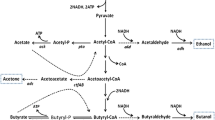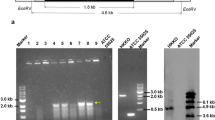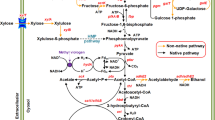Abstract
Clostridium acetobutylicum has been considered as an attractive platform host for biorefinery due to its metabolic diversity. Considering its capability to overproduce butanol through butyrate, it was thought that butyric acid can also be efficiently produced by this bacterium through metabolic engineering. The pta-ctfB-deficient C. acetobutylicum CEKW, in which genes encoding phosphotransacetylase and CoA-transferase were knocked out, was assessed for its potential as a butyric acid producer in fermentations with four controlled pH values at 5.0, 5.5, 6.0, and 6.4. Butyric acid could be best produced by fermentation of the CEKW at pH 6.0, resulting in the highest titer of 26.6 g/l, which is 6.4 times higher than that obtained with the wild type. However, due to the remaining solventogenic ability of the CEKW, 3.6 g/l solvents were also produced. Thus, the CEKW was further engineered by knocking out the adhE1-encoding aldehyde/alcohol dehydrogenase to prevent solvent production. Batch fermentation of the resulting C. acetobutylicum HCEKW at pH 6.0 showed increased butyric acid production to 30.8 g/l with a ratio of butyric-to-acetic acid (BA/AA) of 6.6 g/g and a productivity of 0.72 g/l/h from 86.9 g/l glucose, while negligible solvent (0.8 g/l ethanol only) was produced. The butyric acid titer, BA/AA ratio, and productivity obtained in this study were the highest values reported for C. acetobutylicum, and the BA/AA ratio and productivity were also comparable to those of native butyric acid producer Clostridium tyrobutyricum. These results suggested that the simultaneous deletion of the pta-ctfB-adhE1 in C. acetobutylicum resulted in metabolic switch from biphasic to acidogenic fermentation, which enhanced butyric acid production.




Similar content being viewed by others
References
Blazeck J, Alper H (2010) Systems metabolic engineering: genome-scale models and beyond. Biotechnol J 5:647–659
Canganella F, Wiegel J (2000) Continuous cultivation of Clostridium thermobutyricum in a rotary fermentor system. J Ind Microbiol Biotechnol 24:7–13
Clark SW, Bennett GN, Rudolph FB (1989) Isolation and characterization of mutants of Clostridium acetobutylicum ATCC 824 deficient in acetoacetyl-coenzyme A:acetate/butyrate:coenzyme A-transferase (EC 2.8.3.9) and in other solvent pathway enzymes. Appl Environ Microbiol 55:970–976
Collas F, Kuit W, Clement B, Marchal R, Lopez-Contreras AM, Monot F (2012) Simultaneous production of isopropanol, butanol, ethanol and 2,3-butanediol by Clostridium acetobutylicum ATCC 824 engineered strains. AMB Express 2:45
Cooksley CM, Zhang Y, Wang H, Redl S, Winzer K, Minton NP (2012) Targeted mutagenesis of the Clostridium acetobutylicum acetone-butanol-ethanol fermentation pathway. Metab Eng 14:630–641
Crown SB, Indurthi DC, Ahn WS, Choi J, Papoutsakis ET, Antoniewicz MR (2011) Resolving the TCA cycle and pentose-phosphate pathway of Clostridium acetobutylicum ATCC 824: isotopomer analysis, in vitro activities and expression analysis. Biotechnol J 6:300–305
Desai RP, Harris LM, Welker NE, Papoutsakis ET (1999a) Metabolic flux analysis elucidates the importance of the acid-formation pathways in regulating solvent production by Clostridium acetobutylicum. Metab Eng 1:206–213
Desai RP, Nielsen LK, Papoutsakis ET (1999b) Stoichiometric modeling of Clostridium acetobutylicum fermentations with non-linear constraints. J Biotechnol 71:191–205
Durre P (2011) Fermentative production of butanol—the academic perspective. Curr Opin Biotechnol 22:331–336
Dusseaux S, Croux C, Soucaille P, Meynial-Salles I (2013) Metabolic engineering of Clostridium acetobutylicum ATCC 824 for the high-yield production of a biofuel composed of an isopropanol/butanol/ethanol mixture. Metab Eng 18:1–8
Dwidar M, Park JY, Mitchell RJ, Sang BI (2012) The future of butyric acid in industry. Sci World J 2012:471417
Fayolle F, Marchal R, Ballerini D (1990) Effect of controlled substrate feeding on butyric acid production by Clostridium tyrobutyricum. J Ind Microbiol 6:179–183
Fouad M, Abou-Zeid AA, Yassein M (1976) The fermentative production of acetone-butanol by Clostridium acetobutylicum. Acta Biol Acad Sci Hung 27:107–117
Green EM (2011) Fermentative production of butanol—the industrial perspective. Curr Opin Biotechnol 22:337–343
Green EM, Boynton ZL, Harris LM, Rudolph FB, Papoutsakis ET, Bennett GN (1996) Genetic manipulation of acid formation pathways by gene inactivation in Clostridium acetobutylicum ATCC 824. Microbiology 142(Pt 8):2079–2086
He GQ, Kong Q, Chen QH, Ruan H (2005) Batch and fed-batch production of butyric acid by Clostridium butyricum ZJUCB. J Zhejiang Univ Sci B 6:1076–1080
Huang J, Cai J, Wang J, Zhu X, Huang L, Yang ST, Xu Z (2011) Efficient production of butyric acid from Jerusalem artichoke by immobilized Clostridium tyrobutyricum in a fibrous-bed bioreactor. Bioresour Technol 102:3923–3926
Huang L, Gibbins LN, Forsberg CW (1985) Transmembrane pH gradient and membrane potential in Clostridium acetobutylicum during growth under acetogenic and solventogenic conditions. Appl Environ Microbiol 50:1043–1047
Jang YS, Kim B, Shin JH, Choi YJ, Choi S, Song CW, Lee J, Park HG, Lee SY (2012a) Bio-based production of C2-C6 platform chemicals. Biotechnol Bioeng 109:2437–2459
Jang YS, Lee J, Malaviya A, Seung DY, Cho JH, Lee SY (2012b) Butanol production from renewable biomass: rediscovery of metabolic pathways and metabolic engineering. Biotechnol J 7:186–198
Jang YS, Lee JY, Lee J, Park JH, Im JA, Eom MH, Lee J, Lee SH, Song H, Cho JH, Seung DY, Lee SY (2012c) Enhanced butanol production obtained by reinforcing the direct butanol-forming route in Clostridium acetobutylicum. mBio 3:e00314–12
Jang YS, Malaviya A, Cho C, Lee J, Lee SY (2012d) Butanol production from renewable biomass by clostridia. Bioresour Technol 123:653–663
Jang YS, Malaviya A, Lee J, Im JA, Lee SY, Lee J, Eom MH, Cho JH, Seung DY (2013) Metabolic engineering of Clostridium acetobutylicum for the enhanced production of isopropanol-butanol-ethanol fuel mixture. Biotechnol Prog. 29:1083–1088
Jiang Y, Xu C, Dong F, Yang Y, Jiang W, Yang S (2009) Disruption of the acetoacetate decarboxylase gene in solvent-producing Clostridium acetobutylicum increases the butanol ratio. Metab Eng 11:284–291
Jones DT, Woods DR (1986) Acetone-butanol fermentation revisited. Microbiol Rev 50:484–524
Lee J, Jang YS, Choi SJ, Im JA, Song H, Cho JH, Seung DY, Papoutsakis ET, Bennett GN, Lee SY (2012a) Metabolic engineering of Clostridium acetobutylicum ATCC 824 for isopropanol-butanol-ethanol fermentation. Appl Environ Microbiol 78:1416–1423
Lee JY, Jang YS, Lee J, Papoutsakis ET, Lee SY (2009) Metabolic engineering of Clostridium acetobutylicum M5 for highly selective butanol production. Biotechnol J 4:1432–1440
Lee SY, Park JH, Jang SH, Nielsen LK, Kim J, Jung KS (2008) Fermentative butanol production by clostridia. Biotechnol Bioeng 101:209–228
Lee SY, Sohn SB, Kim HU, Park JM, Kim TY, Orth JD, Palsson BØ (2012b) Genome-scale network modeling. In: Wittmann C, Lee SY (eds) Systems metabolic engineering. Springer, Netherlands, pp 1–23
Lehmann D, Honicke D, Ehrenreich A, Schmidt M, Weuster-Botz D, Bahl H, Lutke-Eversloh T (2012a) Modifying the product pattern of Clostridium acetobutylicum: physiological effects of disrupting the acetate and acetone formation pathways. Appl Microbiol Biotechnol 94:743–754
Lehmann D, Lutke-Eversloh T (2011) Switching Clostridium acetobutylicum to an ethanol producer by disruption of the butyrate/butanol fermentative pathway. Metab Eng 13:464–473
Lehmann D, Radomski N, Lutke-Eversloh T (2012b) New insights into the butyric acid metabolism of Clostridium acetobutylicum. Appl Microbiol Biotechnol 96:1325–1339
Liu X, Zhu Y, Yang S-T (2006a) Butyric acid and hydrogen production by Clostridium tyrobutyricum ATCC 25755 and mutants. Enzyme Microb Technol 38:521–528
Liu X, Zhu Y, Yang ST (2006b) Construction and characterization of ack deleted mutant of Clostridium tyrobutyricum for enhanced butyric acid and hydrogen production. Biotechnol Prog 22:1265–1275
Lutke-Eversloh T, Bahl H (2011) Metabolic engineering of Clostridium acetobutylicum: recent advances to improve butanol production. Curr Opin Biotechnol 22:634–647
Malaviya A, Jang YS, Lee SY (2012) Continuous butanol production with reduced byproducts formation from glycerol by a hyper producing mutant of Clostridium pasteurianum. Appl Microbiol Biotechnol 93:1485–1494
Mermelstein LD, Papoutsakis ET (1993) In vivo methylation in Escherichia coli by the Bacillus subtilis phage Φ 3T I methyltransferase to protect plasmids from restriction upon transformation of Clostridium acetobutylicum ATCC 824. Appl Environ Microbiol 59:1077–1081
Moura M, Broadbelt L, Tyo K (2013) Computational tools for guided discovery and engineering of metabolic pathways. In: Alper, H. S., (Ed.), Systems Metabolic Engineering. vol. 985. Humana Press, pp. 123-147
Nair RV, Papoutsakis ET (1994) Expression of plasmid-encoded aad in Clostridium acetobutylicum M5 restores vigorous butanol production. J Bacteriol 176:5843–5846
Papoutsakis ET (2008) Engineering solventogenic clostridia. Curr Opin Biotechnol 19:420–429
Sambrook J, Fritsch EF, Maniatis T (1989) Molecular cloning: a laboratory manual, 2nd edn. Cold Spring Harbor Laboratory, Cold Spring Harbor, NY
Schmidt M, Weuster-Botz D (2012) Reaction engineering studies of acetone-butanol-ethanol fermentation with Clostridium acetobutylicum. Biotechnol J 7:656–661
Sillers R, Chow A, Tracy B, Papoutsakis ET (2008) Metabolic engineering of the non-sporulating, non-solventogenic Clostridium acetobutylicum strain M5 to produce butanol without acetone demonstrate the robustness of the acid-formation pathways and the importance of the electron balance. Metab Eng 10:321–332
Tracy BP, Jones SW, Fast AG, Indurthi DC, Papoutsakis ET (2012) Clostridia: the importance of their exceptional substrate and metabolite diversity for biofuel and biorefinery applications. Curr Opin Biotechnol 23:364–381
Yang X, Tu M, Xie R, Adhikari S, Tong Z (2013) A comparison of three pH control methods for revealing effects of undissociated butyric acid on specific butanol production rate in batch fermentation of Clostridium acetobutylicum. AMB Express 3:3
Zhang C, Yang H, Yang F, Ma Y (2009) Current progress on butyric acid production by fermentation. Curr Microbiol 59:656–663
Zhang Y, Yu M, Yang ST (2012) Effects of ptb knockout on butyric acid fermentation by Clostridium tyrobutyricum. Biotechnol Prog 28:52–59
Zhu Y, Liu X, Yang ST (2005) Construction and characterization of pta gene-deleted mutant of Clostridium tyrobutyricum for enhanced butyric acid fermentation. Biotechnol Bioeng 90:154–166
Acknowledgments
This work was supported by the Technology Development Program to Solve Climate Changes on Systems Metabolic Engineering for Biorefineries from the Ministry of Science, ICT and Future Planning through the National Research Foundation of Korea (NRF-2012-C1AAA001-2012M1A2A2026556).
Author information
Authors and Affiliations
Corresponding authors
Additional information
Yu-Sin Jang and Hee Moon Woo contributed equally to this work.
Rights and permissions
About this article
Cite this article
Jang, YS., Woo, H.M., Im, J.A. et al. Metabolic engineering of Clostridium acetobutylicum for enhanced production of butyric acid. Appl Microbiol Biotechnol 97, 9355–9363 (2013). https://doi.org/10.1007/s00253-013-5161-x
Received:
Revised:
Accepted:
Published:
Issue Date:
DOI: https://doi.org/10.1007/s00253-013-5161-x




